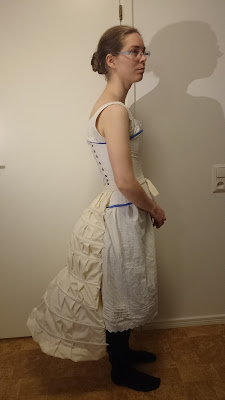In the end, this was the result. Pictures from Gothenburg SteamCon, thanks to Karin for patiently photographing me with my mobile phone camera!
As you can see, in the end I added some gears anyway, on the bag and the hat. After all, I do like gears even if I think there can be too much of them, and I thought the costume needed a clear "this is steampunk" marker.
The bag has added pieces made of painted leather, and some "random shiny stuff" glued on.
I am only partly satisfied with the result. I liked a lot to wear this outfit, but as a garment, I feel that there is some work left to do on the gown. I used the pattern from The Tudor Tailor book, so I had to resize it from "standard men size" to "me size". I thought that would be very simple, as this is not exactly a fitted garment, but it was lot harder than expected. First I scaled it down before drawing the pattern, and then I made a test garment, but I still had to make the actual garment smaller as well. Especially the sleeves turned out way too big - as large as my waist! Ridiculous. Shrinking them meant making the arm holes smaller on a almost finished garment, and then the over sleeves turned out too small instead, and... let's just say it took a while longer than expected, and the gown still does not hang really well. Also, I did not understand all the directions for sewing it that the The Tudor Tailor provided, so I had to make up as I went instead of just following directions.
From the pictures, it is clear that I need to make the sleeves shorter, and add some boning to the over (puff) sleeves to give them more puff and less hanging sadly.
I had been thinking that it would be nice to have something like a chain of office to wear with this, but I had not been able to find anything I liked, or any idea on what I wanted to make. In the Bazar at Gothenburg SteamCon, I was talking to Lykke Banck who has the shop Lucky Gears, and she offered to make one for me. She even finished it the same morning, so I could wear it at the convention! It might not be obvious from the picture (this picture is taken at the very end of the convention so I am quite tired at the time) but I am very happy with how the costume looked with the chain added! I just needed to fix it to the coat somehow, as it kept sliding off.
 |
| Tired picture of gown with chain of office |
 |
| Close up on my dress form. |
The facts:
What is it? A steam punk outfit inspired by 16th century upper class men's clothing and 19th century men's clothing.
The pieces: Hat and gown made by me. Trousers bought from a second hand store. Shirt is a standard shirt, modified so that a bought collar could be attached instead. A black tie from husband's wardrobe. Bag is bought but heavily decorated by me. A clock chain used to hold gown together, and a cravat tie, both likely antique, that I got as gifts. Black modern men's shoes ("Olof, doesn't you need new shoes? I can take care of your old ones."). A medal.
Fabric of gown? Brown velvet from IKEA. Red polyester brocade, previously bought to be a women's 16th century dress. Red cotton for some parts of the lining.
Pattern: Hat and gown from the book The Tudor Tailor.
Total cost: maybe 250 kr for the velvet, 50 kr for lining, and 200kr for the brocade. 170 kr for gears for the hat and bag. Total something like 670 kr, 67 EUR, 67 $. Also 300 kr for custom made chain of office.
Hours to complete? No idea. A lot longer than I thought, and so long that I was very tired of it in the end.
Hours to complete? No idea. A lot longer than I thought, and so long that I was very tired of it in the end.
First worn? At the SteamCon steampunk convention in Gothenburg in November (my blog post of that here).










































